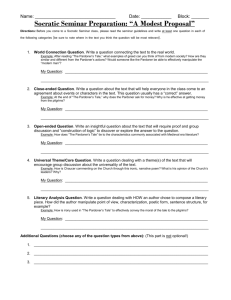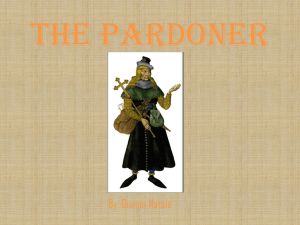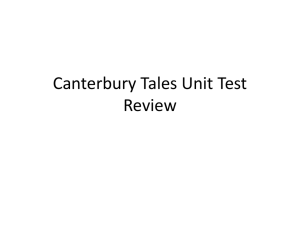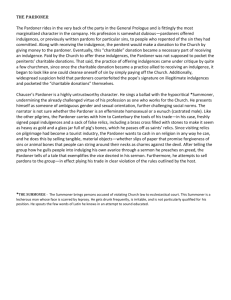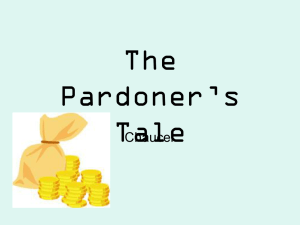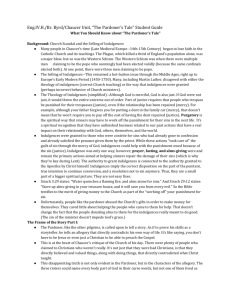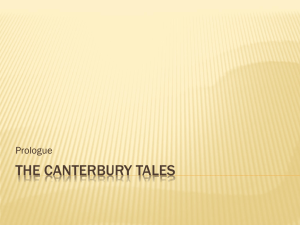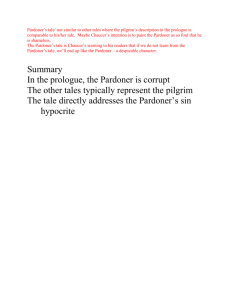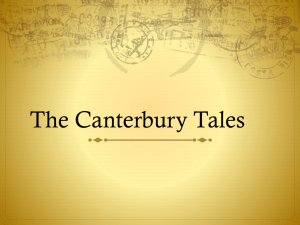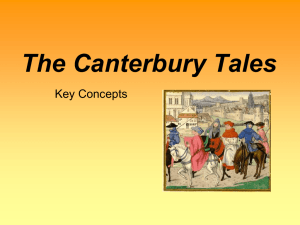the_pardoners_tale
advertisement
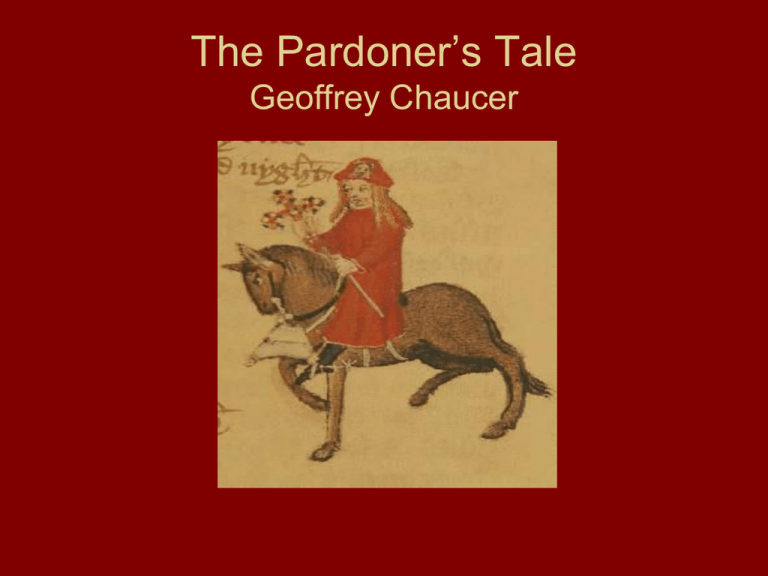
The Pardoner’s Tale Geoffrey Chaucer The Prologue to The Pardoner’s Tale • The host asks the Pardoner to tell a tale; the pilgrims ask for a moral story. • Pardoner tells the company about his occupation- a combination of itinerant preaching & selling promises of salvation. • His sermon topic always stays the same: • Radix malorum est Cupiditas or “greed is the root of all evil.” • He readily admits his relics are all fakes. • His parishioners always believe him & pay for the relics (which he pockets.) • The pardoner admits he preaches solely for money, not to correct sin. • He always preaches about covetousness(the very vice that he himself is gripped by.) The Pardoner’s Tale • Has elements of: • 1) Medieval romance: • adventure • journey--quest-to kill Death (impossible) • heroic figures? Love? • 2) Tale of Morality/Exemplum • a type of story often used to emphasize a moral point- (shows the disastrous effects of greed.) • sins of gluttony/greed or avarice and lust (in the sense of desire for that which doesn't belong to them.) Pardoner’s Tale cont’d… • Grim reaper origin? (Death) • Why would it be popular during this medieval period? • 1) morality of the time You will be punished for your sins • • • 2) death as ever-present hygiene & disease (plague) lack of medicine After life as ever present Pardoner’s Tale cont’d… • In his tale, the Pardoner rails against four vices: gluttony, drunkenness, gambling, and swearing. • The three protagonists in the Pardoner's tale represent these vices. These “sins” are what eventually lead to their downfall. • Three friends (three rioters) decide to go after Death (personified.) • What sets out on a journey becomes their own demise...They find a stash of hidden treasure (enough for all three men to become rich). • They devise a plan: two will guard the treasure and one will go to town for supplies. • But that’s not the only plan hatching… • Read The Pardoner’s Tale Summarize The Pardoner’s Tale Summary • Three rioters are drinking, and hear that a mysterious figure named Death has killed one of their friends. • The friends see an old man (who has been waiting for Death to come and take him.) The old man tells them where they can find Death-in a grove, under a tree. Summary cont’d… • The rioters do not find Death under the tree, but they do find bushels of gold coins. • They can’t take the gold through town during the day, or they will be charged as thieves…they must wait until night. • One rioter goes into town, and two stay behind. Summary cont’d • The two men decide to kill the third guy when he returns from town (so that they will only have to split the money two ways instead of three.) • The youngest rioter devises his own plan to poison the other two men so he can claim the gold for himself. (He puts poison into two of three bottles of wine.) Summary cont’d… • When the sole rioter returns to the grove, he is ambushed and killed. • They sit down to drink their friend’s wine and celebrate, but they drink from a poisoned bottle. Within minutes, they lie dead next to their friend. • Thus, concludes the Pardoner, all must beware the sin of avarice, which can only bring treachery and death. • Then the Pardoner asks the pilgrims to buy a pardon! Questions to ponder… Really, questions to answer… 1. Give one example of the Pardoner’s hypocrisy. 2. Chaucer uses satire as a literary technique in this poem. What is he satirizing? 3. Is this tale fitting to the persona of the Pardoner? What was the description of a Pardoner in medieval times? Yes, there ARE more questions! 4. 5. This story is didactic. How so? Greed (also known as avarice or covetousness) is a sin of excess. Avarice, however, is a blanket term that can describe many types of greedy behavior. These include: disloyalty, deliberate betrayal (especially for personal gain), hoarding of materials or objects, theft and robbery, or simony (where one profits from soliciting goods within the actual confines of a church.) Find 3 examples of avarice in The Pardoner’s Tale and Prologue. There’s lots of irony in this tale! • Three types of irony: – Verbal – Dramatic – Situational • Verbal irony: – This is the contrast between what is said and what is meant. – Most sarcastic comments are ironic. – Ex. The person who says, “Nice going, Einstein,” isn’t really paying anyone a compliment. • Dramatic irony – The contrast between what the character thinks to be true and what we (the reader) know to be true. – Sometimes we know more than what the character knows. Because we know something the character does not, we read to discover how the character will react when he or she learns the truth of the situation. – Ex. A boogeyman is hiding in the attic, but the hero of the movie doesn’t know that. You want him to stay away from the attic. The irony is that the hero thinks he is safe, when you know he’s in danger. • Situational irony – The contrast between what happens and what was expected. – Irony of situation is often humorous, such as when a prank backfires on the prankster. Your job… • Is to look through The Pardoner’s Tale and find the situational and dramatic irony.
